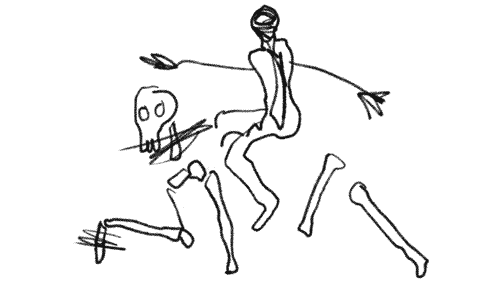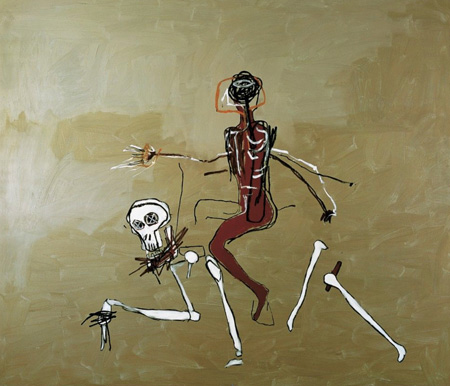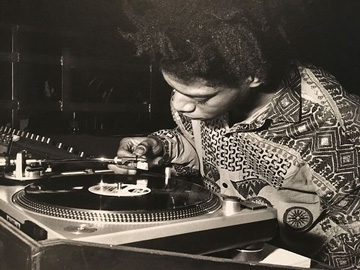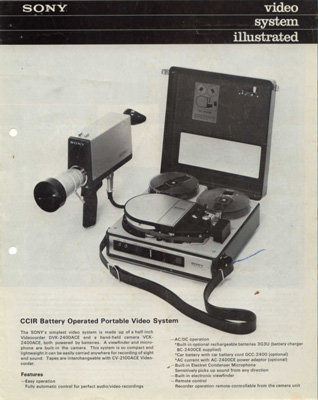The Twanged Line Trembles
Notes on the Research and Development of a multi-channel video project as part of Jet-Black Futures.
 |
In 1988, during the last few months of his life, Jean-Michel Basquiat produced one of his most chilling and enigmatic works. Entitled ‘Riding With Death’, this large work on canvas (98 inches by 114 inches) rendered in acrylic paint and crayon, features a brown figure (Seen by some as a representation of the body of the artist himself) sitting on the back of a skeletal figure, animal-like in its posture but with a human like skull.
Produced so close to his untimely death due to a 'Speedball' overdose on August 12th in his Manhattan Studio, during a period punctuated by his struggle with drug dependency, and shaken by the death during the previous year of his friend, collaborative partner and mentor Andy Warhol, Basquiat may have been intensely aware of his own fragile mortality, his literal ‘riding with death’. According to Liza Ghorbani in her article ‘The Devil on the Door’, “We do know that Basquiat was falling apart in 1988. He seemed like a ghost. He didn’t seem interested in anything – sex, or seeing anybody, or doing the work. He seemed very isolated and alone”. Although some commentators (such as Rachel Smith) have detected a more radical and political intent behind the work, ‘Riding with Death’ feels like the output of an artist haunted by personal demons, picturing himself riding ‘with’ rather than ‘on’ a depiction of the pale horse of the Apocalypse, the angel of death.

However, ‘Riding with Death’ also reminds us of Basquiat’s on-going dialogue with core tropes of art history and his research driven approach to practice, even at moments of personal turmoil.
In her article ‘Riding with Death: Basquiat’s Re-Possession of Aristotle’ Rachel Smith examines his direct quotation of a sketch by Leonardo da Vinci, entitled 'Illustration for his thoughts on Virtue and Envy’ . According to Phoebe Hoban in her book ‘Basquiat’s: A Quick Killing in Art’ , photo evidence exists of Basquiat having a reproduction of the Da Vinci drawing in his studio. This was part of a long term fascination on Basquiat’s part with da Vinci’s work, as evidenced by his 1982 work ‘Leonard da Vinci’s Greatest Hits’ illustrating an dialogue with the artist across four and a half centuries. Within this dialogue, Basquiat ‘riffs’ on Da Vinci’s skeletal figure of death, replacing the nude female figure with his own emaciated form and re-engaging with a chilling image of Apocalyptic foreboding for the 'late analogue' age of the 1980s.

|
It is this idea of the ‘riff’, the selective quotation of a passage, mark, symbol, sound or text, and reprocessing it into a new variant that celebrates the ‘genetic code’ of its predecessor, that is of interest to me here. Just as Basquiat reached back through time to reprocess Da Vinci’s fragile ink lines into heavily tactile crayon marks across a larger-than-human-scale canvas in order to express the accumulating foreboding that he was experiencing, we continue to engage in acts of ‘quotation’.
For me, one of the fascinations of Basquiat’s work is in the ‘haptic’ quality of his scribbled lines, rendering the surfaces of his works as diagrammatic maps (suggestive of ‘interfaces’) or creating a densely layered ‘Palimpsest’ of criss-crossing marks and texts. These ‘twanged lines’ (to borrow a term from Smith), have always for me been held in a space of tension between the ‘static’ and the ‘shimmering’, the capacity for a fixed mark to vibrate in relationship to its background (field) and through time. For a text, image, symbol or sign, to ‘tremble’.
This notion of the ‘trembling’ image is a reference, (via the Otolith Group) back to Chris Marker’s 1977 film essay ‘A Grin Without a Cat’. The following clip, lifted from Marker's original four hour epic by Dr Allison Rittmayer, isolates the francophone reverberation of the question ‘Why do images sometimes begin to tremble?’
This statement reflects the interplay between the emotional and physical tension experienced by the artist at the time of making; the physical and technical restraints/flaws of the technology/medium; and the effect of these factors on the resultant ‘work’, being embedded as ‘glitch’, as ‘damage’ and ‘blur’ and as ‘scratch’.
Many artists have been fascinated by the aesthetic potential of the ‘accidental’, the drip, the glitch, the tear, the scratch. For a generation of artists during the 1970s and 80s, the rise of music celebrating the ‘scratching’ back and forth of the needle within the groves of analogue vinyl music disks pioneered by black urban DJ cultures emerging initially from the Bronx, New York, created an interest in the ‘quotation’ of the original text (the analogue disk) punctuated by the haptic tearing/reversal/breaking of that text through creative ‘damage’ of the ‘scratch’.

Interestingly, this was a creative form that Jean Michel Basquiat famously engaged extensively with on the ‘alternative’ fringes of the New York hip-hop scene, as celebrated in this 2012 ‘scratch video’ collaborative partners DJ Ze Gonzales and music producer Sam Spiegal, collectively known as N.A.S.A.
A key aspect of ‘hip-hop’ and ‘scratch’ culture was not just the haptic and physical interplay between the body of the DJ, the analogue surface of vinyl record, needle and the motorised turntable, it was also about the emergence of new digital technologies.
This grew out of the conflation of technical innovations and aesthetics from two disparate sources. One was the pioneering experimentation of forms such as ‘Musique concrète’ in the 1940s and its descendants within experimental electronic music. The other was the concept of ‘Dub’ emerging from the ‘Deejay Tradition’ of Jamaican reggae music emerging from the 1960s onwards. In both of these traditions, the ‘sample’, originally analogue, but increasingly formatted within emerging technologies as ‘digital’, became central to these as emerging aesthetics of electronic and digital DJ dance and sonic cultures.
At each moment, visual artists would also respond to these innovations, sometimes in reaction to, and sometimes as collaborative ‘fellow-travellers’ with pioneering musicians and sonic artists.
An important example of this is the artist Nam June Paik. A foundational figure in the development of ‘video art’ during the 1960s, Paik was also deeply embedded within and influenced by 'Musique concrète' as explored by Byeongwon Ha in his paper to the 21st International Symposium on Electronic Art ISEA2015.
The centrality of Nam June Paik’s pioneering work within re-imagining the role of new, popular and mass technological media devices in relationship to innovative contemporary art practice, cannot be overstated. Paik was first to imagine the repurposing of the new technology of the hand-held video camera and portable recorder, and its potential to create a more intimate relationship between the artist and the domain of electronic moving image making.
He was to famously take delivery of the first model of Sony’s DVK-2400/VCR-2400 Battery Operated Portable Video System introduced in 1965. Apparently, on the day Paik picked the camera up (4th October 1965) he immediately used it to document the congestion caused by the visit of Pope Paul VI to New York City and screen the results later that afternoon at Café au Go-Go in Greenwich Village, underlining the immediacy of the new medium. This was just one example of Paik seeming to pre-empt developments which would become common place, in his innovative approach to media practices. As explored in the ‘Tate’ video below, Paik’s ability to seemingly ‘predict’ the future turns of technology within his multi-layered practice and writings, has become almost ‘legendary’.
Nam June Paik’s video practice could be seen as taking the ‘tremble’ of Chris Marker’s blurred and torn film footage into an aesthetic engagement with its ‘televisual’ equivalent, the static, glitch and pixilation of the cathode ray tube. This has been hugely influential to the work of subsequent generations of video artists. In the next post I would like to explore the impact of these and other works on my own practice and interaction with technology, and the language of media.

